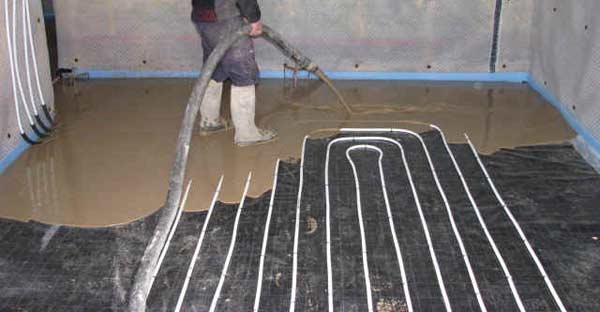With their popularity increasing by the year, heated floors are soon becoming the norm for tilers when starting on a job.
Heated floors cause fluctuations in temperature which makes the screed, adhesive and tiles expand and contract. While the screed and adhesive expand at a similar rate, tiles have a lower coefficient of thermal expansion meaning they grow at a different rate. This can cause the tile to crack or debond due to the stresses placed at the interface between tile and adhesive.
To counter-act this potential for trouble, adequate preparation is crucial, as is the correct selection of adhesive and grout. Here we list the essential preparation for each type of system:
Hot water pipe system
If tiling onto a Hot Water Pipe system (usually incorporated into a reinforced mortar screed), ensure the screed has fully cured. This ranges from one week with BAL Quickset Cement to a minimum of three weeks for a screed containing OPC.
For anhydrite, hemihydrate or calcium sulphate screeds, extra drying time and screed preparation is required. It is advisable to contact BAL TAS directly when this is the case!
Following this period of curing, the screed may then gradually heated up to a maximum operating water temperature of 45° as recommended by the heating manufacturer. It should be maintained at this level for three day, before allowing it to cool to room temperature.
Ensure that the heating system has been turned off, or on in cold temperatures, to ensure the screed is at 15°C before tiling commences.
Cable systems
When using cable systems, check with the manufacturer to ensure the system is compatible with the intended substrate and application areas i.e. wood, screed, kitchen, bathroom etc.
The cables should be bedded into a layer of self-smoothing compound such as BAL Level Max. When using BAL Rapid Mat or Flexbone uncoupling systems, the heating cables should be below the membrane and encased within the levelling compound.
Heating mats
Again check with the manufacturer that the chosen system is compatible with the substrate and to the environment it is being used in.
Before tiling, the surface of the mat should be primed using a contact adhesive, prior to the installation of tiles using the correct adhesive – which we will come onto.
Movement joints
Movement joints and control joints should be incorporated at all perimeters of the screed, including upstands or anything which penetrates the screed, such as columns or pillars. Movement joints are usually formed whilst the screed is being laid. It essential that movement control joints penetrate the full depth of the screed to the insulation layer.
Once tiling commences, movement joints should be incorporated to coincide those in the screed. For floors subject to thermal changes, such as under floor heating, floor area should be divided up by movement joints into bays of size, not greater than 25m2 with and edge length of not greater than 5m. When using uncoupling systems, the bay size can be increased to 40m² and edge length no greater than 8m².
If using BAL Rapid-Mat or BAL Flexbone, the mats should be separated where intermediate movement joints penetrate through the thickness of the tile and bed down to the membrane place on top of the reinforced base screed.
Suitable adhesives
When tiling onto concrete or cement:sand screeds or plywood overlaid floors (min thickness 15mm), a flexible adhesive is required to counteract any thermal movement.
Suitable adhesives include: BAL Single Part Flexible, BAL Flex One, BAL Rapid Flex One, BAL Pourable One, BAL Max Flex Fibre.
For single layers of timber, or where plywood overlay is less than 15mm, consider the use of BAL Rapid Mat uncoupling mat or BAL Flexbone VAried and a flexible adhesive, or BAL Single Part FastFlex– a specialist rubber-crumb adhesive with advanced flexibility.
Suitable Grout
As with your adhesive choice, your chosen grout should also be flexible to allow for thermal movement. Recommended BAL grouts include: BAL Superflex Wide Joint Grout or BAL Micromax2 (BAL Micromax2 with BAL Admix GT1 diluted 1:2 by volume with water when tiling onto single layers of timber when using BAL Single Part FastFlex as the adhesive or when plywood overlay is less then 15mm).
Due to the large number of heating system on the market, we would also recommend to contact BAL Technical and Advisory Service (TAS) for advice before any work is carried out!




